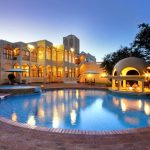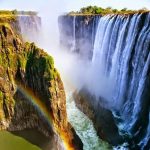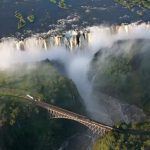So, you’ve heard about this adrenaline-pumping activity called the gorge swing, but have you ever stopped to think about its environmental impact? In this article, we’ll explore just that. We’ll take a closer look at the potential harm the gorge swing can cause to the natural environment and how it is managed to minimize these impacts. So, get ready to swing into a fascinating journey where nature conservation and adventure sports coexist harmoniously.

Introduction
When it comes to extreme sports and adrenaline-pumping activities, the gorge swing has become increasingly popular among thrill-seekers around the world. With its combination of freefalling and swinging through a picturesque gorge, it offers an exhilarating experience like no other. However, it’s important to consider the environmental impact of this activity and how it can be managed to minimize its negative effects. In this article, we will delve into the definition of gorge swing, popular locations for the activity, and provide a comprehensive overview of the environmental impact it can have.
1. Gorge Swing Overview
1.1 Definition of Gorge Swing
A gorge swing is an adventure activity that involves being harnessed and attached to a rope, then jumping off a high platform located on the edge of a steep gorge. As you plunge into the abyss, the rope will act as a pendulum, allowing you to swing back and forth in the gorge. The sensation of freefalling combined with the sweeping motion of swinging creates an unparalleled rush of excitement.
1.2 Popular Locations for Gorge Swing
Gorge swings can be found in various scenic locations around the world. Some of the most popular destinations for this activity include Victoria Falls in Zambia and Zimbabwe, the Queenstown region in New Zealand, and the famous Maasai Mara National Reserve in Kenya. These areas boast breathtaking natural landscapes, making them perfect spots for adventurers to experience the thrill of gorge swinging amidst stunning surroundings.
1.3 Description of the Activity
When participating in a gorge swing, you will typically be provided with a safety harness and equipment by trained professionals. After being securely fastened to the rope, you will take a leap of faith off the platform and begin your descent into the gorge. As you swing back and forth, you’ll feel the rush of wind against your face and the adrenaline coursing through your veins. The experience is both heart-pounding and awe-inspiring, offering a unique perspective of the natural environment.

2. Environmental Impact of Gorge Swing
While gorge swinging may be an exhilarating activity, it is not without its environmental consequences. It is important to recognize and address these impacts to ensure the long-term sustainability of the activity and the preservation of the natural environment. Let’s explore some of the key environmental concerns associated with gorge swing.
2.1 Habitat Disturbance
Gorge swings often require the construction of infrastructures such as platforms, walkways, and safety mechanisms. These human-made structures can disrupt the natural habitat of plants and animals in the area. They may lead to habitat fragmentation, alteration, or loss, which can have significant ecological consequences for the local biodiversity.
2.2 Noise Pollution
The excitement and thrill generated by gorge swinging are often accompanied by loud screams and enthusiastic cheers from participants. This excessive noise can disturb wildlife and disrupt their natural behaviors, such as feeding, breeding, and communication. Prolonged exposure to noise pollution can have adverse effects on wildlife populations, particularly sensitive species.
2.3 Potential for Soil Erosion
The installation and operation of gorge swing infrastructure may require extensive earthworks, including excavation and construction activities. These activities have the potential to result in soil erosion, as they disturb the top layers of soil and expose it to erosion by wind and water. Soil erosion can lead to the loss of fertile soil, negatively impacting vegetation growth and nutrient cycling processes.
2.4 Waste Generation
With the increasing popularity of gorge swing, the generation of waste, both organic and non-organic, becomes a significant concern. Disposable equipment, food packaging, and other forms of waste created by participants and operators can accumulate and contribute to environmental pollution if not managed properly.
2.5 Threat to Wildlife
Gorge swing activities, especially in ecologically sensitive areas, may pose a threat to local wildlife. The presence of large numbers of visitors and the associated infrastructure can disrupt natural animal movement patterns, disturb nesting and breeding sites, or result in collisions with wildlife. These disturbances can have long-lasting consequences for indigenous species, potentially leading to population decline or local extinctions.
3. Management Strategies for Minimizing Environmental Impact
Recognizing the environmental impact of gorge swing is only the first step. To ensure the ongoing sustainability of the activity, various management strategies can be implemented to minimize its negative effects. Let’s explore some of the key strategies for mitigating the environmental impact of gorge swing.
3.1 Site Selection
Choosing the appropriate site for gorge swing activities is crucial in minimizing environmental impact. The selection process should consider factors such as the ecological sensitivity of the area, the presence of threatened or endangered species, and the potential for habitat disturbance. By avoiding or minimizing impacts on ecologically sensitive areas, the negative consequences of gorge swing can be significantly reduced.
3.2 Environmental Impact Assessments
Prior to the establishment of a gorge swing facility, conducting comprehensive environmental impact assessments is essential. These assessments should evaluate the potential environmental impacts on the surrounding ecosystems, wildlife, and local communities. By identifying potential issues early on, necessary measures can be implemented to minimize and manage the impacts effectively.
3.3 Conservation Education
Educating participants about the importance of environmental conservation and the impact of their actions can play a vital role in minimizing the environmental footprint of gorge swing. Providing information on local flora and fauna, ecosystem dynamics, and sustainable practices can raise awareness and encourage responsible behavior among participants.
3.4 Regulation and Monitoring
Establishing clear regulations and monitoring systems is crucial in effectively managing the environmental impact of gorge swing. Regulations can ensure compliance with environmental laws, set standards for minimizing impacts, and outline penalties for non-compliance. Regular monitoring allows for the identification of potential issues and ensures the adherence to established guidelines.
3.5 Waste Management Practices
Implementing effective waste management practices is essential to minimize the environmental impact of gorge swing. This includes reducing waste generation through practices such as packaging reduction, promoting reuse, and encouraging participants to bring reusable water bottles and containers. Proper segregation, recycling, and responsible disposal of waste should also be prioritized.
3.6 Noise Mitigation
To minimize the noise pollution associated with gorge swing, noise mitigation measures should be implemented. This can include using sound barriers or natural features to help absorb or redirect noise, setting limits on noise levels, and enforcing quiet zones during sensitive periods, such as wildlife breeding seasons.

4. Site Selection Criteria
Choosing suitable locations for gorge swing activities is critical in minimizing the potential environmental impact. Certain criteria should be considered during the site selection process to ensure the preservation of the natural environment.
4.1 Minimizing Ecologically Sensitive Areas
When selecting sites for gorge swing, it is important to avoid or minimize impacts on ecologically sensitive areas. These areas may include protected habitats, critical ecosystems, or locations that support threatened or endangered species. By considering the ecological significance of potential sites, the negative consequences of gorge swing can be mitigated.
4.2 Accessibility and Infrastructure
An important consideration in site selection is accessibility and the necessary infrastructure to support the activity. Ideally, sites should already have existing infrastructure or be easily accessible to minimize the need for extensive construction and associated habitat disturbance. Favorable sites should also have the capacity to accommodate visitors without overloading local resources.
4.3 Proximity to Human Settlements
Selecting sites for gorge swing that are reasonably distant from human settlements can help mitigate noise pollution and disturbance to local communities. The activity’s proximity to sensitive areas, such as residential areas or places of cultural significance, should also be considered to preserve the quality of life for local residents and respect their cultural values.
5. Environmental Impact Assessments
Conducting thorough environmental impact assessments at various stages of the gorge swing operation is essential for effective environmental management. By assessing the potential impacts before, during, and after the activity, mitigation measures can be implemented and continuously improved upon. Let’s explore the different stages of environmental impact assessments.
5.1 Pre-activity Assessments
Before establishing a gorge swing activity, a pre-activity assessment should be conducted. This assessment identifies potential environmental impacts, evaluates the ecological sensitivity of the area, and takes into account local regulations and stakeholder concerns. The findings from this assessment guide the design and planning process to ensure minimal environmental disturbance.
5.2 During-activity Assessments
During the operation of a gorge swing activity, ongoing assessments should be conducted to monitor environmental impacts and identify any new issues that may arise. These assessments can include monitoring noise levels, waste management practices, habitat disturbance, and impacts on wildlife. By identifying and addressing issues in real-time, adjustments can be made to minimize further environmental damage.
5.3 Post-activity Assessments
After the completion of a gorge swing activity, post-activity assessments should be conducted to evaluate the effectiveness of the implemented mitigation measures and assess the overall environmental impact. This assessment provides valuable insights into the success of environmental management strategies and helps refine future management practices.
5.4 Use of Qualified Assessors
To ensure the accuracy and reliability of environmental impact assessments, it is crucial to involve qualified assessors. These assessors should have the necessary expertise, knowledge, and experience to conduct thorough assessments and analyze the potential impacts of gorge swing on the environment. Utilizing qualified assessors helps maintain the integrity and credibility of the assessment process.

6. Conservation Education
Conservation education plays a vital role in minimizing the environmental impact of gorge swing. By raising awareness, providing information, and promoting responsible behavior, participants can be actively engaged in environmental protection efforts. Let’s explore how conservation education can be implemented in the context of gorge swing.
6.1 Raising Awareness among Participants
Before embarking on their gorge swing adventure, participants should receive comprehensive orientation and awareness programs. These programs can highlight the importance of protecting the natural environment, the impact of their actions, and sustainable practices they can adopt during the activity. By understanding the implications of their actions, participants can actively contribute to minimizing negative environmental impacts.
6.2 Knowledge Transfer to Local Communities
It is essential to involve and educate local communities about the environmental impact of gorge swing. By fostering relationships with nearby communities, sharing information, and involving them in the decision-making process, local residents become active stakeholders in environmental protection efforts. This knowledge transfer ensures that the local communities value and participate in sustainability initiatives related to gorge swing.
6.3 Collaboration with Environmental Organizations
Collaboration with established environmental organizations can enhance the effectiveness of conservation education initiatives. Environmental organizations can provide expert guidance, resources, and access to educational programs for participants. Partnering with these organizations facilitates the dissemination of knowledge, fosters a culture of environmental responsibility, and ensures the long-term preservation of the natural environment.
7. Regulation and Monitoring
Implementing comprehensive regulations and monitoring mechanisms is essential in managing the environmental impact of gorge swing. By ensuring compliance, conducting regular audits, and enforcing penalties for non-compliance, the activity can be conducted in a responsible and sustainable manner.
7.1 Compliance with Environmental Laws
Regulatory frameworks play a crucial role in minimizing the environmental impact of gorge swing. Local and national environmental laws should be established and enforced to govern the operation of gorge swing activities. These laws can cover aspects such as habitat protection, noise limits, waste management, and adherence to environmental impact assessments.
7.2 Regular Audits and Inspections
To ensure compliance with environmental regulations, regular audits and inspections should be conducted. These audits and inspections can evaluate various aspects, including waste management practices, noise pollution levels, habitat disturbance, and adherence to environmental impact assessment recommendations. By conducting regular assessments, areas for improvement can be identified and appropriate actions can be taken.
7.3 Punitive Measures for Non-compliance
Implementing punitive measures for non-compliance is crucial in promoting responsible behavior and adherence to environmental regulations. Penalties or fines can be levied on operators who fail to meet regulatory standards, encouraging them to prioritize environmental protection. By imposing consequences for non-compliance, the overall environmental impact can be effectively managed and minimized.

8. Waste Management Practices
Effectively managing waste generated by gorge swing activities is essential to prevent environmental pollution and maintain the pristine condition of the surrounding habitat.
8.1 Reduction, Reuse, and Recycling
The principles of reducing, reusing, and recycling should be at the forefront of waste management practices. By minimizing waste generation through measures such as packaging reduction and promoting the use of reusable items, the amount of waste requiring disposal can be significantly reduced. Encouraging proper segregation and establishing recycling systems also contribute to sustainable waste management.
8.2 Disposal of Non-recyclable Waste
Proper disposal of non-recyclable waste is crucial to prevent environmental pollution. Waste that cannot be recycled should be disposed of in designated waste management facilities that meet proper environmental standards. These facilities should be located away from sensitive habitats to prevent contamination of soil and water sources.
8.3 Proper Handling of Hazardous Substances
Some aspects of gorge swing activities, such as equipment maintenance or cleaning, may involve the use of hazardous substances. It is essential to implement proper handling, storage, and disposal practices for these substances to prevent pollution and harm to the environment. Operators should adhere to all relevant safety guidelines and regulations to ensure the responsible management of hazardous materials.
8.4 Clean-up of Debris
Post-activity clean-up efforts should be a priority for gorge swing operators. This includes removing any debris, litter, or waste generated during the activity from the gorge and surrounding areas. By thoroughly cleaning up after each session, the visual impact of gorge swing is minimized, and the site is restored to its natural state.
10. Collaboration with Local Communities
Collaborating with local communities is instrumental in managing the environmental impact of gorge swing. By engaging stakeholders, providing economic benefits, and supporting community development projects, the activity can coexist with the surrounding communities in a mutually beneficial and sustainable manner.
10.1 Engaging Local Stakeholders
Engaging with local stakeholders, including community leaders, residents, and indigenous groups, ensures that their concerns and priorities are considered during the establishment and operation of gorge swing activities. Regular communication, consultation, and participation of local stakeholders build trust and help foster positive relationships between operators and the community.
10.2 Providing Economic Benefits
By providing economic benefits to local communities, gorge swing activities can become a catalyst for sustainable development. This can include offering employment opportunities, sourcing local goods and services, and contributing to local businesses. The economic benefits generated by the activity can create incentives for the community to support and participate in environmental protection efforts.
10.3 Supporting Community Development Projects
Supporting community development projects can further strengthen the bond between operators and local communities. Investments in education, healthcare, infrastructure, or environmental initiatives can help improve the overall well-being of the community. By actively contributing to the development of the local community, gorge swing operators demonstrate their commitment to responsible and sustainable practices.
In conclusion, gorge swing activities offer an exhilarating experience for adventure seekers around the world. However, it is important to consider and address the environmental impact of such activities to ensure long-term sustainability. By implementing management strategies such as careful site selection, comprehensive environmental impact assessments, conservation education, regulation and monitoring, waste management practices, and collaboration with local communities, we can minimize the negative environmental impact of gorge swing. Balancing the thrill of the activity with the preservation of the natural environment is crucial to ensure that future generations can also enjoy the wonders of gorge swinging while protecting our planet.














